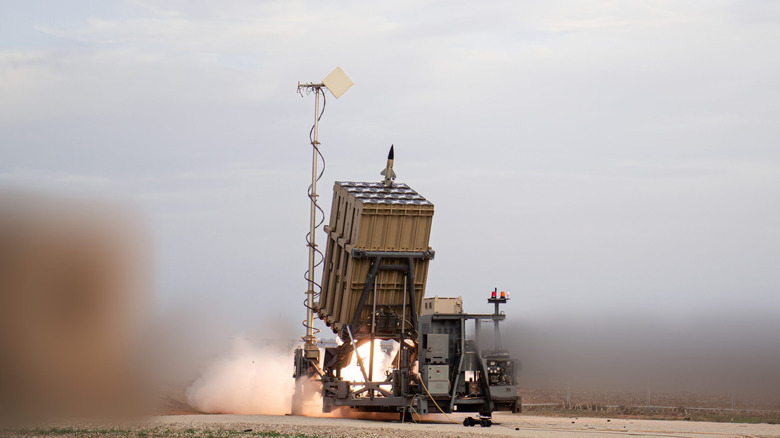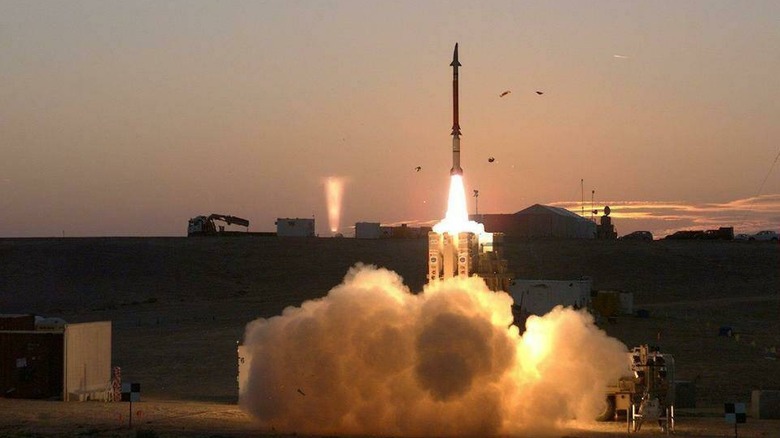David's Sling: What We Know About The Backup To Israel's Iron Dome
Israel's missile protection system offers one of the world's most up-to-date and comprehensive defensive packages for the nation's largest cities. Like many similar systems, the entire suite is composed of numerous tiered layers of defense, each one highly specialized in intercepting different types of ordnance. These range from the massive Arrow System, Israel's anti-ballistic missile defense grid that uses Arrow-2 and Arrow-3 interceptor missiles, down to the Iron Dome point-defense system designed to intercept cheap, short-range munitions at relatively close range. In total, Israel boasts four such anti-missile countermeasures — in order of greatest to closest-range, these are: Arrow, David's Sling, THAAD, and the Iron Dome.
David's Sling, a system manufactured by Israeli firm Rafael Advanced Defense Systems, is marketed as an upper-tier comprehensive countermeasure package against medium and long-distance missile strikes. It's primarily designed to defeat high-volume asymmetric attacks that singular anti-missile munitions like the Arrow grid can't handle. For instance, it's effective against threats such as terminal-phase MIRV-capable ordnance, large-caliber multiple-rocket fire, drone strikes, and incoming aircraft.
David's Sling is a relatively new system, going online in 2017. The system was jointly developed by Rafael and RTX, the latter of which manufactures the system's missile firing units. The actual missile it uses, called the Stunner missile, is a two-stage kinetic missile made in the U.S. by Raytheon Missile Systems. Let's take a closer look at this defense package, what its specs are, and its strengths and weaknesses.
Anatomy of David's Sling and the Stunner missile
First, let's start with the missile itself. The Stunner doesn't have a conventional warhead; instead, it defeats incoming munitions by intercepting and physically slamming into them at supersonic speeds, known as a hit-to-kill (HTK) weapon. To this end, the missile is maneuverable and packed with a suite of active and passive arrays to locate fast-moving targets. However, a new version featuring a warhead may be in development. Each missile is lightweight, with multipulse thrusters and advanced onboard sensors.
The launchers are trailer-mounted, featuring multiple Stunner missiles coupled to a ground-based radar array — though it may also be launched from Israel's 272-strong fleet of fighter jets in the future. Codenamed ELM-2084, the ground-based radar system tracks up to 1,100 targets at a range of roughly 295 miles with a 120-degree azimuth and 50-degree elevation. It projects a cone in the air that relays up to 1,100 incoming munitions, rotating around once every two seconds. It's a formidable combination, which Raytheon claims can defeat 92% of the world's ballistic missile inventory.
The strengths of this system are that it's relatively light, flexible, and affordable, though "affordable" is a slight misnomer, as each missile costs approximately $1 million. Most of that money is likely poured into its advanced sensors and control surfaces. It's apparently well worth the investment, though, with Finland and Germany also having procured the system. However, while it is extremely maneuverable, it still lacks an explosive warhead. Therefore, even near-misses result in no functional damage, which is why maneuverability is so important.
The strengths and weaknesses of the mass-swarm HTK platform
Many HTK weapons, like the common Patriot air-defense missile used extensively in the Ukraine War, feature tiny explosive charges that pepper an area with metal fragments like a supersonic shotgun, improving the odds of a successful hit on small, fast-moving targets like drones. Conversely, the Stunner is a pure HTK weapon with no explosive payload at all.
This has several obvious benefits, such as lowering the risk of collateral damage and reducing weight. However, it means that nothing happens if a Stunner missile misses its target. It has a formidable sensor suite to locate and intercept enemy missiles, but there's virtually no failsafe if the system fails to maintain accuracy or goes for a decoy. Nevertheless, it proves highly effective against cruise missiles and mid-range munitions, with the Stunner capable of ranges up to 186 miles.
The weaknesses of such a system are well-documented and center around the threats they're expected to encounter. Some drones and missiles will violently maneuver to counter these defenses, and being maneuverable enough to intercept these requires exorbitantly deep pockets. For example, Patriot missile systems cost upwards of hundreds of millions of dollars to acquire in bulk, while almost any faction can buy a commercial-grade drone and strap some C4 on it for a fraction of the price. However, cheaper HTK alternatives are shaving down the costs; mounted on technicals, these low-cost and low-risk systems offer a compelling alternative. So while the David's Sling missile system is certainly complicated and expensive now, the technology is undergoing rapid and thorough development to curtail some of that up-front expenditure.


